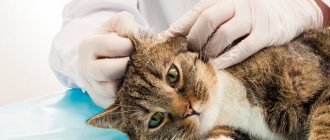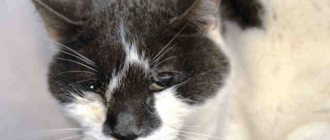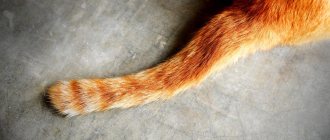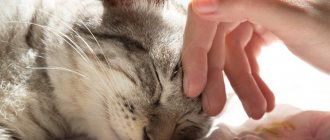One of the most common injuries among domestic felines is a fracture of a cat’s paw , usually the hind leg. These animals always go for walks “by themselves,” hide under warm cars, climb onto open windows and love to climb trees. All this can cause a serious fracture.
If such an injury occurs, you should immediately contact a veterinarian. After all, a fracture can be of varying degrees of severity and treatment must be complete and professional. In this article we will look at the types of fractures, how to treat them and care for them afterwards.
Clinical signs of fracture in cats
With an open bone fracture, it is extremely easy to understand that the cat has a fracture. The cat will have an open wound, swelling of the soft tissues and, as a rule, severe pain. In some cases, you may notice the presence of bone fragments in the wound. With a closed fracture in a cat, everything is much more complicated. There will be pain, swelling, or swelling of the soft tissue at or below the fracture site. Therefore, it is much more difficult to immediately determine where the fracture is, since the fracture may be above the site of swelling, and the swelling on the joint is lower.
How doctors can help
Before choosing the most effective treatment method, the veterinary surgeon will examine the injured limb and order an x-ray examination. The method allows not only to confirm the diagnosis, but also to determine the location, type and complexity of the fracture, and the presence of damage in the periosteal structures. X-ray examination, as well as palpation of the injury, are carried out after preliminary anesthesia.
Conservative treatment
Closed and uncomplicated fractures in small animals can be successfully treated with conservative methods. First of all, pain shock is eliminated and the pet is anesthetized. In order to restore the integrity of the bone, immobilization of the damaged limb is used using a splint or splint.
The main condition for the rapid and correct fusion of bone fragments is the limitation of the animal’s mobility. Physiotherapy, vitamin therapy, and drugs that improve osteosynthesis will help speed up the regeneration process.
Operation
Complicated types of fractures require surgical intervention. The operation allows you to set large bone fragments or remove small ones. It is important to perform osteosynthesis as quickly as possible after the fracture is detected. Modern veterinary surgery involves the use of fixing metal structures (pins, knitting needles, plates, etc.) in osteosynthesis. Metal structures made from special steel and titanium remain in the animal’s body for life.
Control radiograph of the cat after surgery; a metal plate was installed at the fracture site.
Surgical intervention will also be required if, for any reason, conservative treatment methods do not result in complete recovery. In this case, the surgeon resorts to deliberately breaking the improperly fused bone.
Fractured paw in a cat
As for fractures of the limbs (paws) in cats, a distinctive feature is a clear violation of the ability to support the affected limb, that is, the cat cannot walk on the affected leg. This is especially pronounced in displaced fractures of the extremities. With a non-displaced fracture, weight bearing on the limb can be preserved; the cat can even walk with a limp on the sore leg.
| Forearm fracture in a cat | Comminuted fracture of the tibia in a cat, direct view | Comminuted fracture of the tibia in a cat |
Spinal fracture in a cat
If a cat has spinal fractures, the clinical picture will be somewhat different. In addition to pain, the cat will have neurological deficits depending on the extent and location of the spinal cord injury. Outwardly, this will manifest itself in this way: if a cat has a fracture of the spine in the cervical region with a spinal cord injury, then in addition to pain, the function of all paws may be impaired and the cat will not be able to move normally. If the spine is fractured in the thoracic or lumbar region, in addition to pain, neurological disorders will manifest as weakness or inability to move on the hind legs. In some cases, there may be urinary or fecal incontinence.
A little anatomy
The spinal column region in cats is formed by a plurality of vertebrae, extending from the end of the skull bones to the tail. Individual vertebrae are connected to each other by special discs called intervertebral discs.
The function of the intervertebral discs is to significantly reduce the load and absorb shock during jumps and minor impacts. In addition, intervertebral discs provide increased flexibility of the spine. In the area between the vertebrae themselves and the discs there are a large number of processes of the spinal brain.
The cat's spine begins at the cervical region and consists of seven vertebrae. The peculiarity of the cervical vertebrae is their size and the ability to rotate 180 degrees. The first vertebra has a specific appearance, called the atlas, and is attached directly to the animal’s skull. The second cervical vertebra, epistropheus, is also not similar in structure to ordinary vertebrae.
The cervical region smoothly transitions into the thoracic region and already consists of 13 vertebrae, which have special notches for attaching true ribs that have a specific extension to the tail. There are 16 true ribs in cats, the remaining five pairs are false and are not attached to the spine.
The structure of the lumbar region is determined by the presence of large large vertebrae in the amount of seven pieces. They are unusually large and have characteristic processes on the upper part of the axis. These processes are necessary for attaching muscle fibers that maintain the normal position of the internal organs in the peritoneum. In addition, the vertebrae have elastic ligaments that allow the animal to perform rotational movements with the back of the body during the jump and to maintain balance.
The area of the sacral joint is formed by three vertebrae, firmly connected to each other and forming the sacral bone part. The tail of cats is long and has from 20 to 23 vertebrae in its structure. Cats, which due to natural features have virtually no tail, do not have caudal vertebrae.
Possible spinal injuries entail serious damage to the roots of the nerve fibers of the spinal cord. The most common causes of fractures and vertebral displacements in cats are various falls from great heights, injuries received from being hit by a car, and bites received from other animals. The danger lies not only in trauma to bone structures, but also in the risk of swelling, bleeding and rupture of nerve fibers.
Fracture of the pelvis and sacrum in a cat
With a fracture of the pelvis or sacrum, the clinical picture may be similar to a fracture of the lumbar spine: the cat will not be able to move on its hind legs and there may be disturbances in urination and defecation. In some cases, if the fracture occurs in a specific area of the pelvis, such as the acetabulum, the cat will only show signs of dysfunction in one leg.
Pelvic fracture in a cat (fracture of the pubic bone and sacroiliac joint)
Symptoms
The degree of neurological impairment depends on the severity of the spinal injury and location. If the vertebra is broken without displacement or it is not the body but the process of the vertebra that is damaged, then the cat retains the ability to walk. In such cases, the main symptoms will be pain and decreased motor activity (no running, no jumping).
In case of serious injuries, paralysis of the limbs occurs:
- If the cervical or thoracic spine is damaged, all four legs are removed.
- In case of lumbar injury - only the posterior ones.
In addition to being unable to walk, an injured animal may lose the ability to empty its bowels and bladder. Another ominous symptom is the lack of pain sensitivity in the paralyzed area.
When spinal injuries occur in animals, spinal shock develops. The cat can die from problems with blood circulation and internal organs. Clear signs of shock:
- mucous membranes are pale (white) or blue;
- rapid shallow breathing;
- pulse weak, frequent, uneven;
- body temperature decreases (sometimes to 33-35 °C and below);
- the pet is indifferent to external stimuli and loses consciousness.
The state of shock progresses quickly and requires immediate medical intervention.
What to do if your cat has a fracture
If you suspect that your cat has a fracture, the most important thing for the owner is not to panic, not to give the cat all kinds of medications and not to try to correct the fracture reduction on their own. If a cat’s front paw is fractured, namely a fracture of the shoulder, forearm (radius and ulna), metacarpal bones or phalanges, you must try to fix the paw so that the cat cannot further injure it and worsen the situation with repositioning the fracture. At home, you can try to make a splint from a dense material (thick cardboard, plastic or wood) and secure it loosely with a bandage. If a cat with a fracture is aggressive, it is better not to try to fix the fracture, but to put the cat in a carrier and bring it to the clinic. If the cat has an open fracture, then you should try to treat the wound with an antiseptic solution (chlorhexidine 0.05%) and apply a protective bandage to the wound before arriving at the clinic.
If a cat's hind paw is fractured, namely a fracture of the femur, tibia (tibia and fibula), metatarsal bones and phalanges, first aid should be provided to the cat in the same way as for a fracture of the front paw.
If your cat's jaw is broken, it is enough to put on a special collar or bandage the jaw and bring it to the clinic.
If you suspect a fracture of the spine, pelvis, ribs or sacrum, you must try to immobilize the cat; the easiest way to do this is to use a carrier. You should not try to actively move a cat or pick it up without first securing it, as the cat may experience severe pain and displacement of bone structures. This can worsen her general and neurological condition after the fracture.
Types of fractures
Depending on the time of occurrence, veterinarians are faced with genetic and acquired fractures. Congenital fractures account for about 2.5% of cases. During the development of kittens in the womb, there may be compression of the fetuses by the uterus, as well as tension during the birth process.
The development of rickets, osteoporosis and osteomalacia due to imbalances in the cat’s diet during the period of gestation of kittens even before birth, leads to fractures of the front or hind limbs in babies. Acquired damage to bone structures is detected when the rules of obstetric care are violated, as well as at the stage of postnatal care.
In veterinary surgery, several types of acquired fractures are distinguished. They depend on the main factors - traumatic or associated with pathology. In representatives of the cat family, one of the main factors that provoke a fracture is trauma from a fall from a great height. In addition, a cat walking on the street without the supervision of its owner may suffer from a gunshot wound when the animals are hunted by their ardent haters.
Fracture is formed as a result of the development of bone pathology in osteosarcomas, osteomalacia, when there is a loss of strength in the tissue structure. The nature of the damage to the tubular bone is also taken into account when making a diagnosis.
There are open, closed and incomplete (partial) paw fractures. Based on the direction of the damage to the bone structure, veterinary medicine specialists distinguish the following types:
- transverse;
- longitudinal;
- oblique;
- screw (manifests itself when the animal’s paws get stuck);
- splintered;
- jagged, resulting from a lack of minerals or from pathological fractures associated with disease.
Diagnosis of a fracture in a cat
Diagnostic measures in a veterinary clinic should be aimed not only at diagnosing the fracture itself, but also at detecting pathologies that may negatively affect the general condition of the cat after injury or be a contraindication for surgical treatment of the fracture.
Diagnostic measures in a veterinary clinic for a fracture in a cat include:
- general examination,
- collection of tests (biochemical and clinical blood tests),
- X-ray examination in at least two projections,
- ECHO of the heart,
- in some cases, an ultrasound of the abdominal organs is performed.
Very often in veterinary practice, a cat with a fracture experiences polytrauma - a combination of injuries. For example, lung injury - pneumothorax, rupture of the bladder or spleen, as well as the development of various bleeding in the abdominal cavity. In such cases, first of all, the general condition of the animal is stabilized, and when the threat to life has passed, the fracture is treated.
Treatment
Immediately after an injury, the task of doctors is adequate pain relief and anti-shock therapy. While the cat's condition is unstable, most diagnostic procedures can lead to deterioration. A spinal fracture may not be the only problem, but may be accompanied by a bruise or rupture of internal organs, abdominal bleeding, or accumulation of fluid or air in the chest cavity.
Once an accurate diagnosis has been established, the doctor recommends conservative treatment or surgery. The final decision is made by the owner based on the information provided about the cost of treatment, possible complications and prognosis for recovery.
Conservative treatment
Drug treatment involves the use of large doses of steroid hormones:
- metipred,
- dexamethasone,
- prednisolone.
These substances relieve swelling of the spinal cord as much as possible. The animal is limited in mobility.
Conservative treatment is justified if there is no pronounced displacement of the vertebrae, and pain sensitivity and reflexes of the limbs are preserved.
Surgical treatment
The surgeon's goal is to relieve spinal cord compression and stabilize the vertebrae. For this purpose, a wide variety of metal structures are used. After the intervention, the cat receives:
- antibiotics,
- painkillers,
- anti-inflammatory drugs.
Rehabilitation period
Regardless of the chosen treatment method, an acute period after injury and a recovery period are distinguished. Rehabilitation of a cat with a back injury can take a long time. During this period, doctors prescribe:
- various physical therapy;
- B vitamins;
- basic care required for a paralyzed animal.
Is a hospital needed for a cat with a fracture?
The inpatient department of our veterinary clinic is an ICU - this is a resuscitation and intensive care unit for animals in a life-threatening condition. Such a department in a veterinary clinic is a salvation for cats with polytrauma and fractures. When a cat is admitted to a veterinary clinic in the intensive care unit, all necessary measures will be taken very quickly to stabilize the condition. First of all, the cat will undergo manipulations to eliminate factors that threaten the life of the animal, namely, in case of pneumothorax - urgent removal of air from the pleural cavity, in case of shock - special infusion therapy, pain relief, etc. For a cat with a fracture in a state of shock, veterinarians will provide pain relief with special drugs available only in the department, that is, it is simply impossible to provide competent pain relief to a cat at home, since the substances are potent and are not available without special permission.
Then, after anesthesia and first aid, veterinarians in the ICU carry out further diagnostics of the cat’s condition, namely, X-ray examination, blood tests, ultrasound and cardiac ECHO. The types and sequence of treatment and diagnostic measures may vary. This depends on the condition of the cat at the time of admission.
If the cat’s condition requires long-term observation and stabilization, a hospital is vital for the cat. Veterinarians at the inpatient department at our center work around the clock, so proper care for a cat with a fracture will be provided at all times.
First aid
In case of an open form of injury, first of all, it is necessary to remove protruding foreign objects, dirt and sharp bone fragments from the wound channel, and stop the bleeding. This can be done by pressing a clean cloth wrapped around your finger against the wound.
If a large vessel on the hind limb is damaged, the bleeding is stopped by squeezing the artery on the inside of the thigh. If bleeding and damage to the front paw are detected, the artery under the elbow joint is clamped. The wound must be treated with an antiseptic solution: hydrogen peroxide, chlorhexidine, miramistin, potassium permanganate solution.
Fixing the limb
After treating the wound and stopping the bleeding, the owner should begin fixing the damaged limb. A small board, a wide ruler, or a plastic panel will be suitable as a tire. The fixation device should be slightly longer than the limb itself.
Scheme for bandaging a cat's paw
The damaged paw should be secured to the splint using a bandage, belt, belt, or tape. The bandage should be tight, but not squeezing the blood vessels. Bandaging is not carried out in the area of an open wound.
Pain reliever for injury
Veterinary experts do not recommend that owners independently use painkillers for fractures. This is due to the fact that without feeling pain, the animal can cause even more harm to itself, aggravating its situation. Pain relief can smooth out the clinical picture of the injury. In addition, the pet will need sedation for X-ray examinations, and pre-administration of an analgesic will adversely affect the cat's health.
Arranging transportation to the clinic
After providing competent first aid, a sick pet must be transported to a specialized facility as quickly as possible. For this purpose, thick cardboard, a piece of plywood, boards, a panel from a car, etc. will be suitable in the field. It is important that the surface is smooth and hard.
Transportation will have to be carried out in a supine position. The sick animal should be secured with straps or rope to a hard surface at hand. This needs to be done in the area of the shoulder blades and pelvis. The cat should be transported in the back seat of the car.
How to treat a broken bone in a cat
Treatments for bone fractures in cats depend on many factors, such as the type of fracture, which bone is broken, and whether the fracture is open or closed.
For open fractures in cats, external fixation devices are installed to avoid infection of the bone.
For closed fractures in cats, fractures are fixed using various plates, intramedullary placement of pins or wires.
Treatment for a bone fracture in a cat can be conservative or surgical. Conservative treatment of a fracture in a cat is used, for example, when one or two bones of the metacarpus or metatarsus are fractured. Conservative treatment of fractures in cats can also be used for incomplete forearm fractures (greenstick fractures), when only the radius is broken without displacement.
In veterinary practice, surgical treatment of fractures in cats is more often used, since it ensures the cat’s early ability to support the affected limb and provides fewer complications.
For a closed fracture of the femur or shoulder in cats, plate placement techniques (compression, support, limited contact, LCP, and others) can be used. For distal fractures, fixation using Kirschner wires can be used. In some cases, fracture fixation can be used in cats using pins.
For femoral neck fractures, the most commonly used technique is resection arthroplasty.
For closed fractures of the tibia or forearm, depending on the type of fracture, plates or an external fixation device (bilateral single-plane external fixation device) can be used.
For closed fractures of the metacarpal or metatarsal bones, intramedullary fixation is used using Kirschner wires.
In case of a fracture of the spine or pelvis, the fracture is fixed using Kirschner wires and bone cement, fiducial wires and bone cement, or using plates and screws.
When is surgery needed?
There are many reasons that will determine how to treat a fracture in a cat. The most important of them are the general health of the pet, the age of the pet, the type of injury and what bones it broke. At times, for injuries to the hind legs, a fixing bandage or splint is sufficient. If surgical intervention is still necessary, then a screw, pin (metal rod), wire or metal plate is installed into the cat’s bone to hold the bone fragments.
Treatment of injury is most often surgical; it includes fixation of bone fragments and ensuring stable preservation of the functions of damaged tissues. After surgical intervention, doctors prescribe therapeutic measures aimed at eliminating inflammation around the injury, healing and restoring the general condition.
Fracture treatment
Caring for a cat after surgery
During recovery, limit physical activity (including walks), visit a veterinarian as prescribed, give the cat vitamins, or, if the doctor recommends, switch the animal to health food, which helps restore bone tissue and regeneration.
If the veterinarian has applied a splint, cast or bandage, the owner must constantly monitor the bandage so as not to cause complications in the animal. The dressing should normally look like its original condition and be completely dry. Also, the condition of the tire is examined by a veterinarian at least three times a month.
Note! After visiting the veterinarian, the main thing is to follow his instructions. Also, after the cast and wires are removed, you need to allow time for recovery. According to experts, this may take more than a month. Recovery is monitored using radiography.
Clinical cases of treatment of fractures in cats at Pride
Clinical case of treatment of femoral neck fracture
The Bengal cat Bonya has been limping on his right pelvic limb for 3 weeks. Therapeutic treatment did not lead to the desired results, and the cat was admitted to an orthopedic doctor E.S. Maslova. Using X-ray diagnostics and examination, an old fracture of the femoral neck was discovered. Bona underwent all the necessary preoperative examinations and was prepared for surgery - resection arthroplasty. This is a surgical treatment method that allows you to preserve the functionality of the joint by resection of the femoral head. After a successful operation, Bonya went home and is now undergoing rehabilitation.
Veterinary surgeon specialist in traumatology, orthopedics and neurology Maslova E. S.
Treatment of a displaced hip fracture in a cat
A patient with a very serious character, the cat Vasily (16.5 years old), was admitted to Pride with a displaced hip fracture on the left pelvic limb. During the examination, a veterinary traumatologist decided to stabilize the fracture through surgery with the installation of an external titanium support plate with limited contact.
This design allows for good fixation of the fracture in order to achieve the best fusion. Removal of this plate is necessary only in rare cases; as a rule, animals are left with it for life.
After a preoperative examination and infusion therapy, Vasily underwent osteosynthesis. He tolerated the anesthesia and the surgery itself well, despite his advanced age.
Veterinary surgeon, specialist in traumatology, orthopedics and neurology Maslova E. S. Veterinary anesthesiologist Litvinovskaya K. V.
Treatment of an old femoral neck fracture in a cat
A cat was admitted to the veterinary office with complaints of lameness in the right pelvic limb for a month. During examination by veterinarian Maslova E.S. crepitus and tenderness were detected in the right hip joint. To make a diagnosis, an X-ray examination was performed, which revealed an old femoral neck fracture. This problem can be solved by using surgical treatment, namely resection arthroplasty (resection of the femoral head). This technique preserves joint mobility without the presence of the femoral head. Chuck the cat passed all preoperative examinations (cardiac ECHO and blood tests) and was successfully operated on. All the time after the operation, the cat was under the strict supervision of doctors and hospital assistants, as well as his anesthesiologist K.V. Litvinovskaya.
Veterinary surgeon specialist in traumatology, orthopedics and neurology Maslova E. S. Veterinary anesthesiologist Litvinovskaya K. V.
Author of the article: Maslova E. S. veterinary surgeon, specialist in orthopedics, neurology and neurosurgery
Features of caring for an injured animal
In addition to additional procedures, the animal should receive vitamins for a speedy recovery.
To alleviate the condition of a pet after a fracture and eliminate pathological symptoms of the spine, owners need to know how to properly care for it. In most cases, injured pets lose normal ability to urinate. As a rule, without serious injury and no complications during surgery, function is restored within 1-2 months after the fracture. To speed up the healing process and ensure normal urination for the cat, it is recommended to carry out physiotherapeutic procedures prescribed by the veterinarian. It is equally important to give your pet vitamin complexes, thanks to which bone structures are restored more quickly.











